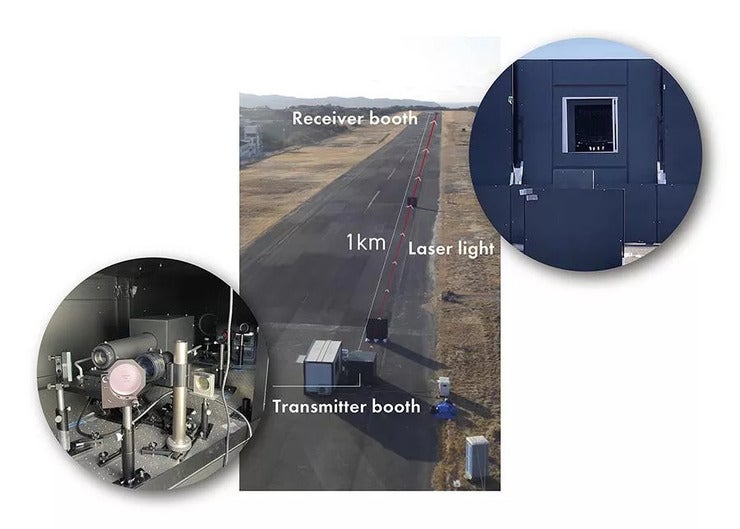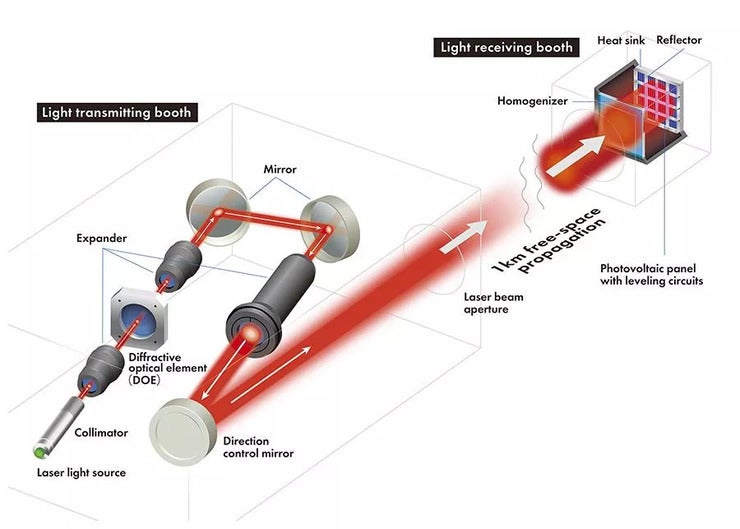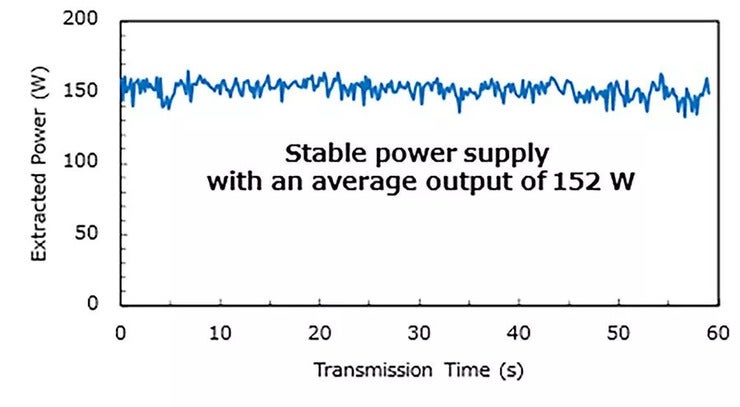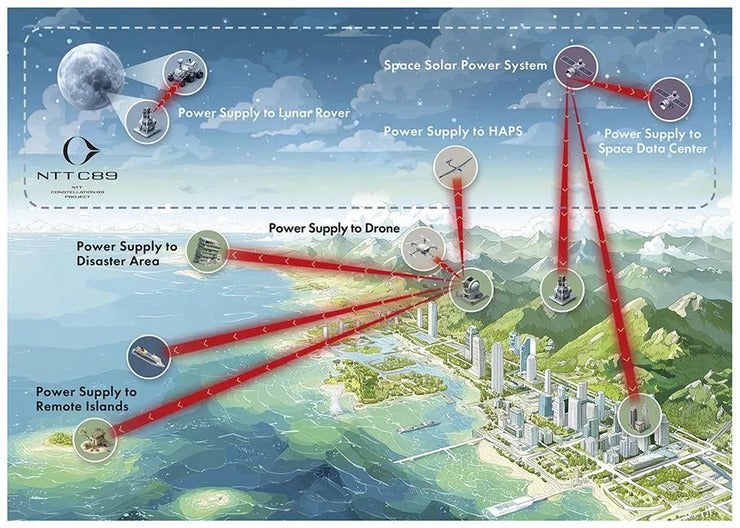NTT Inc. and Mitsubishi Heavy Industries Ltd. (MHI) performed an optical cordless power transmission experiment using a laser beam to wirelessly transmit power over a range of one kilometer. By irradiating a laser beam with an optical power of 1 kW, the group did well in obtaining 152 W of electric power. This marks the world’s highest performance of an optical wireless power transmission (Number 1 utilizing a silicon photoelectric conversion aspect in an environment with strong climatic turbulence.

The outcome shows the expediency of supplying power to distant websites. In the future, it is anticipated to be applied to on-demand power transmission to remote islands and disaster-stricken areas where power cables can not be mounted. This accomplishment was released in the British magazine Electronics Letters on August 5, 2025
Wireless Power Transmission Systems
In recent times, wireless power transmission innovations for gadgets such as mobile phones, wearable gadgets, drones, and electrical vehicles, which can provide electrical energy without utilizing cables, have actually garnered boosting focus. There are 2 types of cordless power transmission systems: one uses microwaves and the various other usages laser beam of lights. Microwave wireless power transmission is currently in useful usage and its use is expanding. On the various other hand, optical cordless power transmission making use of laser beam of lights has not been put into functional usage, however it is anticipated to understand portable long-distance wireless power transmission on the order of kilometers by taking advantage of the high directivity of laser beam modern technology.
Future leads envision the growth of next-generation framework with the ability of supplying power and expanding interaction coverage in situations and areas where electricity or communication networks are not available, such as during calamities, on remote islands, mountainous areas, or mixed-up. This includes providing power specifically to certain locations or moving systems such as drones. Attaining such very exact and long-distance power distribution needs laser-based wireless power transmission that makes the most of its solid directionality.
Existing Innovation Obstacles and Accomplishments of This Experiment
The performance of optical wireless power transmission innovation is normally reduced, and improvement of performance is a problem for practical usage. One of the factors for this is that when a long-distance laser beam of light circulates, especially in the environment, the intensity distribution becomes irregular, and the efficiency of transforming the laser light beam right into electrical power in the photoelectric conversion component comes to be reduced.
In this experiment, researchers incorporated NTT’s beam-shaping innovation with MHI’s light-receiving technology to boost the effectiveness of laser cordless power transmission. The group performed a long-distance optical cordless power transmission experiment in an exterior environment using long-distance level beam forming innovation that formed the beam of light at the transmission side to achieve consistent beam intensity after one kilometer breeding, and outcome present progressing modern technology that suppresses the impact of atmospheric fluctuations with a homogenizer and progressing circuits on the obtaining side.
From January to February 2025, MHI conducted an optical wireless power transmission experiment on a runway at the Nanki-Shirahama Airport Terminal in Shirahama Community, Nishimuro Area, Wakayama Prefecture (Number2 A transmission booth outfitted with an optical system for sending out the laser beam of light was set up at one end of the path, and a function booth consisting of a light-receiving panel was placed one kilometer away.

Throughout transmission, the optical axis of the laser was evaluated a reduced height of around one meter in the air and aligned flat. Therefore, the beam was strongly affected by ground home heating and wind, and the experiment was performed under problems with solid climatic turbulence.
Inside the transmission cubicle, a laser light beam with an optical power of 1, 035 W was produced. Making use of a diffractive optical element (DOE), the light beam was shaped to produce an uniform strength distribution at a range of one kilometer. In addition, a light beam guiding mirror was made use of to specifically guide the designed beam of light toward the getting panel. The beam of light left with the aperture of the transmission cubicle and propagated across one kilometer of open room, ultimately reaching the reception cubicle.
Throughout propagation, climatic turbulence created fluctuations in the beam’s strength, creating locations. These were diffused by a homogenizer in the reception booth, resulting in an uniform light beam being irradiated onto the getting panel. The laser beam of light was then efficiently converted into electrical power (Number3 A silicon-based photoelectric conversion component was taken on for the receiving panel, taking into account both price and availability.

In this experiment, the average electrical power drawn out from the obtaining panel was 152 W (Number 4, corresponding to a wireless power transmission efficiency of 15 %, specified as the proportion of gotten electrical power to sent optical power. This result notes the globe’s highest optical wireless power transmission performance ever before showed using a silicon-based photoelectric conversion component under problems of solid atmospheric disturbance. Furthermore, constant power delivery was efficiently maintained for 30 minutes, verifying the feasibility of long-duration power transmission using this modern technology.

From a safety perspective, the optical transmission system and the receiving panel were each mounted inside booths to stop unexpected exposure to high-power laser beam of lights and the scattering of mirrored light.
Technical Emphasizes
Long-Distance Apartment Beam Of Light Shaping Technology. To boost photoelectric conversion effectiveness, it is essential to make the strength distribution of the beam case on the photoelectric conversion aspect uniform. In this research study, MHI suggested a beam shaping approach that makes it possible for intensity uniformity after long-distance proliferation. In this technique, the external part of the beam is transformed right into a ring-shaped pattern utilizing the result of an axicon lens. The central part of the beam is phase-modulated to broaden through the impact of a concave lens. As the beam of light propagates, the ring-shaped beam and the broadened main beam slowly overlap, leading to an uniform intensity distribution at the target area, as received Number 5

For the experiment, MHI maximized the beam of light design to attain the wanted intensity account at a range of one kilometer. The light beam shaping was implemented making use of a diffractive optical element, which boosted the harmony of the beam strength at the target setting located one kilometer away.
Result Present Leveling Technology. As the laser light beam propagates via the atmosphere, it is influenced by atmospheric disturbance, which disrupts the strength distribution. Although the flat-beam shaping strategy defined over can make the strength circulation a lot more consistent, solid turbulence can still create the development of high-intensity spots, as shown in Figure 6

To resolve this issue, MHI put a light beam homogenizer before the light-receiving panel. The homogenizer diffused high-intensity places to ensure that the beam of light was consistently irradiated onto the panel. In addition, leveling circuits were linked per photoelectric conversion component on the receiving panel. These circuits helped suppress fluctuations in output present caused by atmospheric disturbance and added to a more maintain total power output.
These two innovations make it feasible to achieve beam harmony in kilometer-order transmission, which was tough with traditional beam of light shaping methods, and to support outcome in outside settings. As a result, steady power supply to remote areas such as separated islands and disaster-affected areas is expected to come to be feasible.
Business Functions and the Course Ahead
NTT concentrated on the style and execution of transmission optics such as beam-shaping strategies. Meanwhile, MHI managed the layout and implementation of photodetector optics such as photodetector panels, homogenizers, and leveling circuits.
This modern technology enables the effective and secure transmission of energy over long distances even under climatic disturbance. In this experiment, silicon was utilized as the photovoltaic conversion aspect. However, by employing photovoltaic devices especially developed to match the wavelength of the laser light, also greater power transfer effectiveness can be anticipated. Furthermore, making use of laser source of lights with greater outcome power would make it possible to supply bigger amounts of electrical energy.
Because of this, adaptable and fast power distribution can be attained in remote locations such as disaster-stricken areas and remote islands, where the installation of power line has typically been challenging. Past earthbound applications, a wide variety of new usage instances can additionally be envisioned based on this innovation (Number7 Notably, the high directivity and reduced divergence of laser beam of lights permit the layout of small and light-weight getting gadgets. This is a significant advantage for mobile systems that encounter rigorous limitations in weight and payload ability.

For instance, by incorporating this innovation with light beam steering techniques, it becomes possible to deliver power wirelessly to drones in flight. This avoids operational restrictions such as landing for battery replacement or using tethered power supply cable televisions, enabling long-duration and long-distance constant operation. Such capabilities can enhance disaster-area surveillance as well as wide-area interaction relay in mountainous or naval areas, applications that were formerly challenging to realize.
Additionally, potential applications in space are anticipated, consisting of power distribution to mobile platforms such as HAPS (High-Altitude Platform Terminal), which drops within the range of NTT’s space brand, NTT C 89 Looking even more in advance, the innovation could be put on power space information centers and lunar wanderers, in addition to to room solar power systems in which power is transmitted from geostationary satellites to the ground through laser. These applications represent areas with strong capacity for market expansion.
Via the partnership in between NTT and MHI, the firms have actually understood the globe’s most efficient laser wireless power transfer modern technology under problems highly influenced by atmospheric changes. This success represents a substantial action towards constructing an ingenious technological foundation that can fulfill a wide variety of societal requirements, from calamity feedback to room development.
— POWER modified this material, which was contributed by MHI